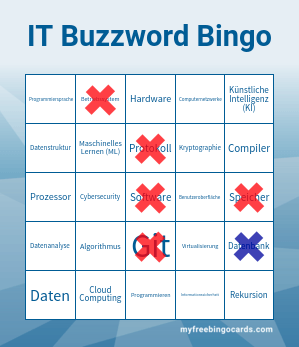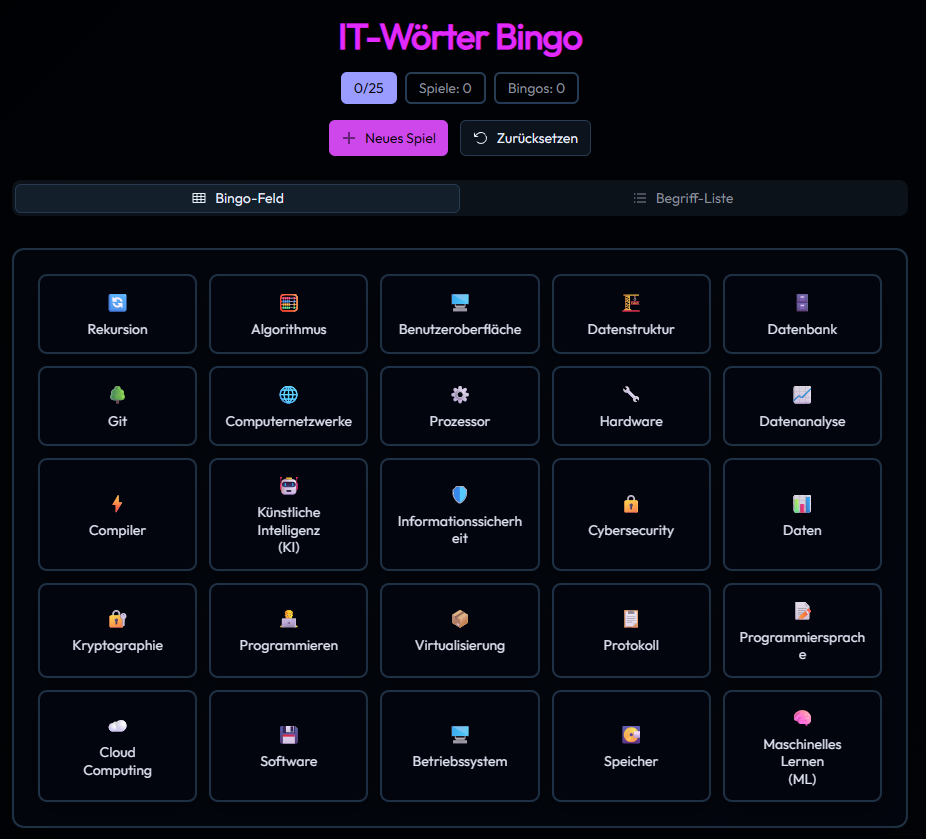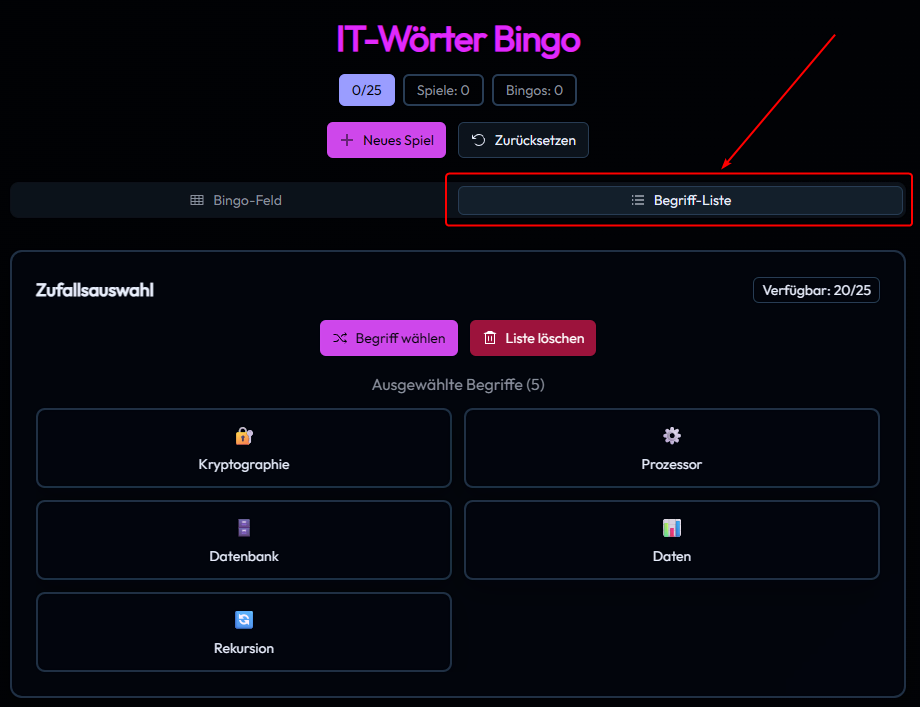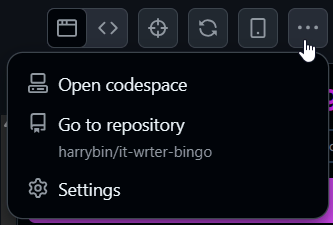Table of contents
Open Table of contents
From Workshop Challenge to AI-Powered Solution
Recently, I had the honor of speaking to tenth-grade students at IGS Hermeskeil school during their career orientation day (see my LinkedIn post). One of the most popular activities we offer during these workshops is playing Buzzword Bingo with IT terms and concepts.
For years, we relied on a free web-based bingo tool. However, it had significant limitations:
- Outdated design that felt like it was stuck in the early 2000s
- Poor usability and confusing interface
- Generic functionality that didn’t fit our specific needs
- Not mobile-friendly for the students

Looking at this interface before the next workshop, I decided it was time to build something better. Something modern, tailored to our needs and more engaging for students.
Discovering GitHub Spark
I had known about GitHub Spark, GitHub’s new AI-powered application builder currently in public preview. While technically available, a colleague mentioned it’s in a somewhat unusual state: generally available but obviously not for him:

GitHub Spark promised to help developers “transform ideas into full-stack intelligent apps and publish with a single click.” That sounded exactly like what I needed.
The First Prompt: Creating the Bingo Game
I started with a single prompt in German (since the app would be used by German-speaking students):
Erstelle ein Bingo spiel, das auf folgenden Begriffen statt Zahlen beruht:
Algorithmus, Hardware, Software, Daten, Git, Protokoll, Speicher,
Prozessor, Benutzeroberfläche, Programmieren, Datenbank, Betriebssystem,
Cybersecurity, Virtualisierung, Cloud Computing, Künstliche Intelligenz (KI),
Maschinelles Lernen (ML), Datenstruktur, Rekursion, Kryptographie,
Informationssicherheit, Compiler, Datenanalyse, Computernetzwerke,
Programmiersprache
Das Spielfeld soll 5x5 Felder groß sein.
Nimm modernes DesignIt’s built for German pupils, so I also used German prompts. Here’s the translation:
Create a Bingo game based on the following terms instead of numbers: Algorithm, Hardware, Software, Data, Git, Protocol, Memory, Processor, User Interface, Programming, Database, Operating System, Cybersecurity, Virtualization, Cloud Computing, Artificial Intelligence (AI), Machine Learning (ML), Data Structure, Recursion, Cryptography, Information Security, Compiler, Data Analysis, Computer Networks, Programming Language The game board should be 5x5 fields in size. Use modern design.
with:
- A 5x5 grid populated with IT terms
- Modern, clean design
- Automatic bingo detection (rows, columns, diagonals)
- Click-to-mark functionality
- Responsive layout for mobile devices
- Random term distribution for each new game

The speed and completeness were genuinely impressive.
Adding the Caller Functionality
For a complete Bingo experience, we needed a way for the workshop leader to randomly call out terms. I added a second prompt:
nun erstelle einen Button, der jedes Mal einen der begriffe zufällig
auswählt aber ein begriff nicht mehrfach ausgewählt werden. Eine Liste
der bereits ausgewählten begriffe soll sichtbar sein.
Die Liste soll auch zurücksetzbar seinTranslation:
Now create a button that randomly selects one of the terms each time, but a term should not be selected multiple times. A list of the already selected terms should be visible. The list should also be resettable.
GitHub Spark understood exactly what I needed and added:
- A separate caller tab for workshop leaders
- Random term selection without repetition
- A visible history of called terms
- A reset button to start new games
- Synchronization between the game board and caller

The Publishing Journey
Initial Deployment with Spark
Publishing through GitHub Spark was remarkably simple (click once to deploy) with one significant limitation: apps published through Spark require GitHub authentication to access, even when set to public. This meant our students would need GitHub accounts to play, which wasn’t practical for a workshop setting.
Creating the GitHub Repository
I decided to leverage Spark’s ability to convert a Spark project into a traditional GitHub repository. This is where things got interesting and educational.
Spark created a well-structured repository with:
- Clean React + TypeScript codebase
- Vite build configuration
- Proper project structure
Looking under the hood revealed that Spark uses standardized templates and best practices, which is reassuring. The generated code is readable, maintainable and follows modern conventions.
GitHub Actions and GitHub Pages
To make the app publicly accessible without authentication, I used GitHub Copilot’s coding agent to create GitHub Actions workflows for automated deployment
The final result: IT-Wörter-Bingo is now publicly accessible through my custom domain hosted on GitHub Pages.
Polishing and Maintenance
Dependency Management
Shortly after creating the repository, Dependabot started flagging outdated npm packages. This highlighted an interesting aspect: Spark generates projects with stable dependencies, but they may not always be the latest versions.
I created an issue for GitHub Copilot’s coding agent to update dependencies and it handled the task efficiently with one important caveat:
Bidirectional Synchronization
This means:
- You can use Spark for high-level editing and feature additions
- You can dive into code for detailed customization
- Both approaches stay synchronized
- You maintain the benefit of Spark’s AI-powered interface while retaining full code control
This bidirectional workflow represents a significant advantage over purely AI-generated code tools.
Beyond Basic Editing
GitHub Spark offers several powerful features that extend beyond simple code generation:

1. GitHub Codespaces Integration
You can seamlessly open any Spark project in GitHub Codespaces for traditional development.
 This provides:
This provides:
- Full VS Code environment
- Access to extensions and tools
- Traditional version control workflows
- Collaborative development capabilities
2. Multi-Device Preview

Spark includes built-in preview capabilities for:
- Desktop browsers
- Mobile devices (responsive preview)
- Different screen sizes and orientations
This eliminated the need for external testing tools during development.
3. Visual Element Editor

Perhaps the most surprising feature: Spark provides a WYSIWYG-style editor where you can:
- Click on individual elements in the preview
- Edit properties visually
- Make layout adjustments without touching code
- See changes reflected immediately
4. Theme and Template Support

Spark supports:
- Theme customization and switching
- Data structure templates
- Asset uploads and management
- Component libraries
5. Integrated Code Editor

Spark includes a full-featured code editor directly in the browser, allowing you to:
- Browse and edit your entire codebase without leaving Spark
- Make precise changes to generated code
- Add custom logic and functionality
- Review file structure and dependencies
- Work with syntax highlighting and basic code intelligence
This integrated editor bridges the gap between AI-generated scaffolding and manual refinement, letting you quickly adjust implementation details while staying in the Spark workflow.
These features blur the line between no-code platforms and traditional development.
When to Use GitHub Spark
Based on my experience, GitHub Spark excels at:
Rapid Prototyping
- Transform ideas into working demos in minutes
- Validate concepts with stakeholders quickly
- Iterate on user interface and functionality
- Test assumptions before committing to full development
Internal Tools
- Build dashboard and admin interfaces
- Create custom utilities for team workflows
- Develop one-off applications for specific needs
- Replace spreadsheet-based processes with proper apps
Educational Projects
- Demonstrate concepts without infrastructure setup
- Let students focus on logic rather than boilerplate
- Provide immediate visual feedback
- Lower the barrier to entry for programming
MVP Development
- Launch minimum viable products rapidly
- Test market fit with real users
- Gather feedback before heavy investment
- Scale to production when validated
Preview Status
The tool is still in preview, which means:
- Features and behavior may change
- Documentation is still evolving
- Some edge cases may not be well-handled
- Production use requires additional validation
Complexity Limits
While Spark excels at certain types of applications, I guess it’s less suited for:
- Complex enterprise applications with extensive business logic
- Applications requiring specialized backend services
- Projects with intricate state management needs
- Systems requiring fine-grained performance optimization
Conclusion
GitHub Spark proved to be exactly what I needed for the Buzzword Bingo project. In 15 minutes, I went from idea to a fully functional, professionally designed web application that students could use immediately.
But beyond solving my immediate problem, Spark demonstrated a compelling vision for the future of application development:
- Rapid ideation and validation through natural language interfaces
- Seamless transitions between high-level and low-level editing
- Production-ready foundations that scale beyond prototypes
- Integration with proven tools like GitHub, Codespaces, and Actions
For developers, Spark isn’t replacing traditional development. Instead, it’s adding a powerful new tool that accelerates the early stages of application creation, allowing us to spend more time on the unique aspects that require human expertise and less time on standard boilerplate.
Whether you’re building internal tools, educational projects, quick prototypes or validating startup ideas, GitHub Spark deserves serious consideration. Just remember: while it’s incredibly fast at getting you started, you’ll still want to understand the code it generates and maintain it properly as your application grows.
The future of development might not be pure code or pure AI but rather a thoughtful combination of both. GitHub Spark represents a significant step in that direction.
Have you tried GitHub Spark for your projects? I’d love to hear about your experiences and what types of applications you’ve built with it. Share your thoughts in the comments or reach out on LinkedIn!
